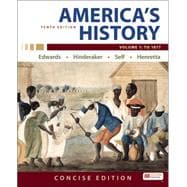About This Book
America's History: Concise Edition, Volume 1
ISBN: 9781319275884
About This Book
"America's History: Concise Edition, Volume 1" is a comprehensive textbook designed to provide students with a deep understanding of American history. This tenth edition, written by Rebecca Edwards, Eric Hinderaker, Robert O. Self, and James A. Henretta, offers a dynamic and analytical approach to the subject, explaining not just what happened but also why events occurred.
Who Uses It?
Primarily, this book is used by students and instructors in introductory American history courses at the college and university levels. It's also a valuable resource for anyone interested in understanding the complexities of American history, including professionals looking to refresh their knowledge or expand their understanding of historical events.
History and Editions
The tenth edition of "America's History: Concise Edition, Volume 1" has been updated to address user feedback, incorporating the latest research and discussions on historical themes. This edition includes detailed visual timelines, marginal glossary, review questions, and special boxed features with firsthand accounts of the period. The book also offers a variety of tools to help students sort out what's most important in American history.
Author and Other Works
Rebecca Edwards is known for her engaging narrative style and her ability to explain complex historical concepts clearly and simply. Eric Hinderaker brings his expertise in historical analysis to the text, ensuring that it remains current and relevant. Robert O. Self and James A. Henretta contribute their insights into the broader historical context, making this edition a comprehensive resource for students.
Key Features
- Comprehensive Coverage: The book covers core developments in American history from 1491 to 1700, including detailed explanations and examples.
- Analytical Approach: The text explains why events occurred, providing an analytical and big-picture approach to American history.
- Visual Aids: Enhanced pedagogical aids include visual timelines, Mapping the Past exercises, and preview reading questions that guide students as they read.
- Interactive Tools: The book is complemented by Achieve, a single, easy-to-use platform that integrates with Respondus for enhanced exam security.
Detailed Information
ISBNs and Formats
- E-book: ISBN-13: 9781319275884
- Print: Available in bound text format (ISBN-13: 9781319557720)
- Package Deals: Includes E-book and E-book (ISBN-13: 9781319528911), Achieve and Paperback (ISBN-13: 9781319430573), and Paperback and Paperback (ISBN-13: 9781319430573)
Publication Details
- Publisher: Macmillan Learning
- Publication Date: 2021
- Number of Pages: Varies by format
- Language: English
Other Editions and Formats
- Tenth Edition: Available through Macmillan Learning and other retailers
- Digital-Only Access: Available for Achieve, LaunchPad, and Achieve Read & Practice
Related ISBNs:
- 9781319277222 (Volume 1)
- 9781319528911 (E-book and E-book package)
- 9781319557720 (Bound text format)
- 9781319430573 (Achieve and Paperback package)
- 9781319430573 (Paperback and Paperback package)
This detailed information section provides a quick reference for all the available formats and sources for "America's History: Concise Edition, Volume 1," making it easier to find and access the book in the preferred format.









